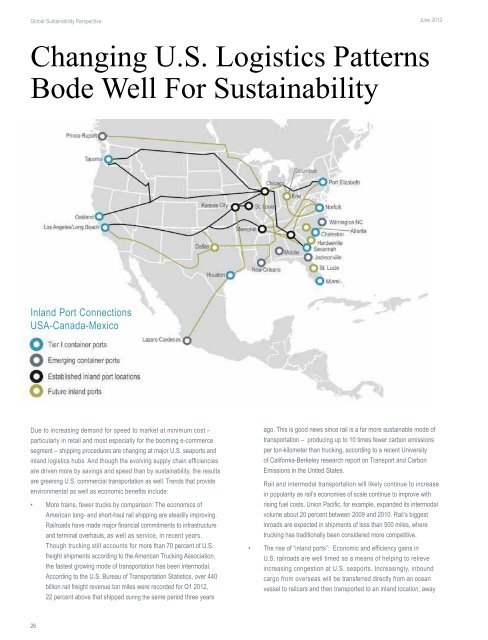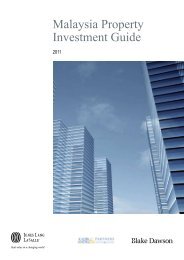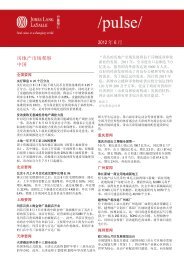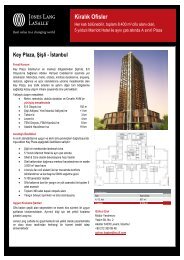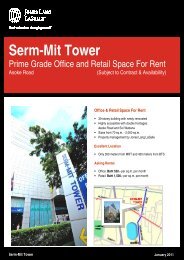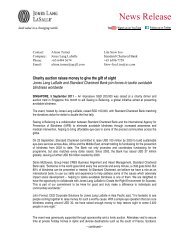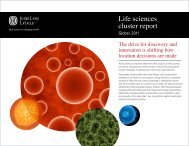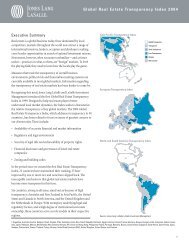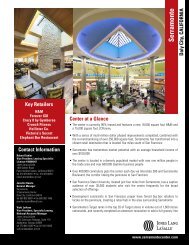Global Sustainability Perspective magazine - Jones Lang LaSalle
Global Sustainability Perspective magazine - Jones Lang LaSalle
Global Sustainability Perspective magazine - Jones Lang LaSalle
Create successful ePaper yourself
Turn your PDF publications into a flip-book with our unique Google optimized e-Paper software.
<strong>Global</strong> <strong>Sustainability</strong> <strong>Perspective</strong><br />
Changing U.S. Logistics Patterns<br />
Bode Well For <strong>Sustainability</strong><br />
Inland Port Connections<br />
USA-Canada-Mexico<br />
Due to increasing demand for speed to market at minimum cost –<br />
particularly in retail and most especially for the booming e-commerce<br />
segment – shipping procedures are changing at major U.S. seaports and<br />
inland logistics hubs. And though the evolving supply chain efficiencies<br />
are driven more by savings and speed than by sustainability, the results<br />
are greening U.S. commercial transportation as well. Trends that provide<br />
environmental as well as economic benefits include:<br />
• More trains, fewer trucks by comparison: The economics of<br />
American long- and short-haul rail shipping are steadily improving.<br />
Railroads have made major financial commitments to infrastructure<br />
and terminal overhauls, as well as service, in recent years.<br />
Though trucking still accounts for more than 70 percent of U.S.<br />
freight shipments according to the American Trucking Association,<br />
the fastest growing mode of transportation has been intermodal.<br />
According to the U.S. Bureau of Transportation Statistics, over 440<br />
billion rail freight revenue ton miles were recorded for Q1 2012,<br />
22 percent above that shipped during the same period three years<br />
June 2012<br />
ago. This is good news since rail is a far more sustainable mode of<br />
transportation – producing up to 10 times fewer carbon emissions<br />
per ton-kilometer than trucking, according to a recent University<br />
of California-Berkeley research report on Transport and Carbon<br />
Emissions in the United States.<br />
Rail and intermodal transportation will likely continue to increase<br />
in popularity as rail’s economies of scale continue to improve with<br />
rising fuel costs. Union Pacific, for example, expanded its intermodal<br />
volume about 20 percent between 2009 and 2010. Rail’s biggest<br />
inroads are expected in shipments of less than 500 miles, where<br />
trucking has traditionally been considered more competitive.<br />
• The rise of “inland ports”: Economic and efficiency gains in<br />
U.S. railroads are well timed as a means of helping to relieve<br />
increasing congestion at U.S. seaports. Increasingly, inbound<br />
cargo from overseas will be transferred directly from an ocean<br />
vessel to railcars and then transported to an inland location, away<br />
from the more congested port itself, for further processing and<br />
distribution. These inland locations, or intermodal centers, serve<br />
as “inland ports,” with some handling as much cargo volumes<br />
as their coastal counterparts.<br />
Inland ports act as an integrated component to U.S. port systems,<br />
creating a logistics “barbell.” With port systems growing in size<br />
and capacity, the inland port provides the counterbalance, with<br />
the two ends connected by a dedicated rail line, originating ondock<br />
at the container terminals with direct access to the inland<br />
port destination. In such fashion, the inland hub provides the<br />
means for ocean cargo to pass through the waterfront terminals<br />
more quickly and more cost effectively, literally “clearing the<br />
decks” for the arrival of the next vessel.<br />
Conclusion: Less shipping pain is sustainability’s gain: What does all this<br />
mean for sustainability? Besides an increase in more environmentallyfriendly<br />
rail transportation, many inland ports are less established than<br />
their coastal counterparts that have been around for decades, even<br />
centuries. Inland ports can be designed from a comparatively clean slate,<br />
incorporating green technologies and practices ranging from renewable<br />
power and water conservation to site plans that preserve natural habitat.<br />
Even when sustainability isn’t in the forefront of American logistical<br />
planning – which is often the case – one thing is clear: The changes<br />
afoot to streamline distribution patterns within the world’s largest<br />
consumer economy should make the U.S. a greener country, as well.<br />
For further information please contact:<br />
Aaron L. Ahlburn<br />
Vice President, Americas Director of<br />
Research, Industrial & Retail,<br />
aaron.ahlburn@am.jll.com<br />
26 27<br />
<strong>Jones</strong> <strong>Lang</strong> <strong>LaSalle</strong><br />
About 40 miles from Chicago, bordered by a BNSF<br />
main railroad on one side and Interstate 55, a major<br />
highway, on the other, is possibly America’s most<br />
sustainable inland port. The RidgePort Logistics Center<br />
contains 14 million square feet of buildings ranging from<br />
200,000 square feet to 2 million square feet, but equally<br />
impressive are environmental benefits such as:<br />
• Almost one-third of the land area set aside for natural habitat<br />
• Wastewater filtration using four different green technologies<br />
• A required tenant composting program, with the end result<br />
used in site planting and landscaping projects<br />
• Plans to construct a limestone mine 200 feet under the<br />
property for aggregate stone used for roads and buildings; this<br />
is expected to eliminate truck trips using 540,000 gallons of<br />
fuel and prevent 10,476,000 pounds of CO2 emissions<br />
• Best management practices to minimize storm water impact<br />
• Solar and wind energy generation<br />
• A sustainable tree farm


